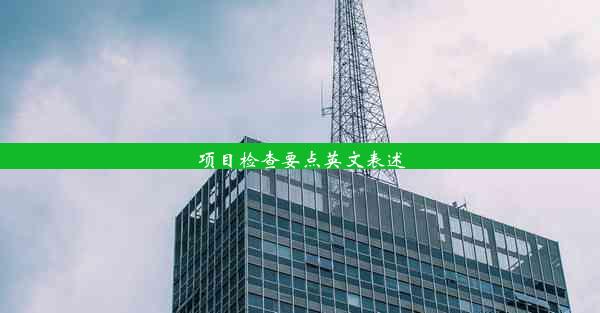
Mastering Project Inspection: Key Points for Success
In the fast-paced world of project management, ensuring that every detail is meticulously checked is crucial for the success of any endeavor. Whether you're overseeing a construction project, managing a software development team, or coordinating a marketing campaign, the ability to conduct thorough inspections can make or break the outcome. This article delves into the essential key points for project inspection, providing you with the insights needed to maintain high standards and achieve excellence.
1. Understanding the Project Scope
Understanding the Project Scope
The first and foremost step in any project inspection is to have a clear understanding of the project scope. This involves:
- Defining Objectives: Clearly outline what the project aims to achieve. This includes both short-term and long-term goals.
- Identifying Stakeholders: Recognize all parties involved, from clients and team members to external vendors and regulatory bodies.
- Establishing Boundaries: Set clear boundaries for what is included and what is not within the project's scope to avoid scope creep.
2. Setting Quality Standards
Setting Quality Standards
Quality is the cornerstone of successful project completion. Here's how to establish and maintain quality standards:
- Developing Quality Metrics: Create measurable criteria that define what constitutes quality in your project.
- Implementing Quality Control Processes: Establish routines and checks to ensure that work meets the predefined standards.
- Regular Audits: Conduct periodic audits to assess the quality of work and identify areas for improvement.
3. Ensuring Compliance
Ensuring Compliance
Compliance with regulations and standards is non-negotiable. Consider the following:
- Understanding Relevant Regulations: Familiarize yourself with all laws and industry standards that apply to your project.
- Training Team Members: Ensure that all team members are trained to adhere to these regulations.
- Regular Compliance Checks: Schedule regular checks to confirm that the project is in line with all legal and industry requirements.
4. Managing Risks
Managing Risks
Risk management is crucial to prevent potential issues from derailing the project. Key aspects include:
- Identifying Potential Risks: Conduct a thorough risk assessment to identify potential issues.
- Developing Risk Mitigation Strategies: Create plans to minimize the impact of identified risks.
- Monitoring and Adjusting: Continuously monitor risks and adjust strategies as needed to keep the project on track.
5. Effective Communication
Effective Communication
Communication is the lifeblood of project management. Here's how to ensure it's effective:
- Regular Meetings: Schedule regular meetings to discuss progress, address concerns, and align expectations.
- Clear Documentation: Maintain comprehensive documentation of all project activities and decisions.
- Feedback Loops: Establish feedback mechanisms to ensure that all team members are on the same page.
6. Utilizing Project Management Tools
Utilizing Project Management Tools
Leveraging the right tools can significantly enhance the efficiency of your project inspections. Consider:
- Project Management Software: Use tools like Trello, Asana, or Jira to track progress and manage tasks.
- Document Management Systems: Implement systems like SharePoint or Google Drive for easy access to project documents.
- Inspection Checklists: Create checklists for different phases of the project to ensure nothing is overlooked.
By focusing on these key points, you can ensure that your project inspections are thorough, effective, and contribute to the overall success of your project. Remember, attention to detail and a proactive approach are your best allies in the world of project management.












